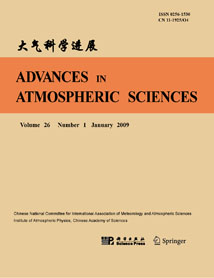| [1] |
ZHAO Juan, WANG Bin, LIU Juanjuan,
2011: Impact of Analysis-time Tuning on the Performance of the DRP-4DVar Approach, ADVANCES IN ATMOSPHERIC SCIENCES, 28, 207-216.
doi: 10.1007/s00376-010-9191-3
|
| [2] |
LIU Juanjuan, WANG Bin,
2011: Rainfall Assimilation Using a New Four-Dimensional Variational Method: A Single-Point Observation Experiment, ADVANCES IN ATMOSPHERIC SCIENCES, 28, 735-742.
doi: 10.1007/s00376-010-0061-9
|
| [3] |
ZHENG Xiaogu, WU Guocan, ZHANG Shupeng, LIANG Xiao, DAI Yongjiu, LI Yong, ,
2013: Using Analysis State to Construct a Forecast Error Covariance Matrix in Ensemble Kalman Filter Assimilation, ADVANCES IN ATMOSPHERIC SCIENCES, 30, 1303-1312.
doi: 10.1007/s00376-012-2133-5
|
| [4] |
Banglin ZHANG, Vijay TALLAPRAGADA, Fuzhong WENG, Jason SIPPEL, Zaizhong MA,
2015: Use of Incremental Analysis Updates in 4D-Var Data Assimilation, ADVANCES IN ATMOSPHERIC SCIENCES, 32, 1575-1582.
doi: 10.1007/s00376-015-5041-7
|
| [5] |
Yaodeng CHEN, Jie SHEN, Shuiyong FAN, Deming MENG, Cheng WANG,
2020: Characteristics of Fengyun-4A Satellite Atmospheric Motion Vectors and Their Impacts on Data Assimilation, ADVANCES IN ATMOSPHERIC SCIENCES, 37, 1222-1238.
doi: 10.1007/s00376-020-0080-0
|
| [6] |
Rong KONG, Ming XUE, Edward R. MANSELL, Chengsi LIU, Alexandre O. FIERRO,
2024: Assimilation of GOES-R Geostationary Lightning Mapper Flash Extent Density Data in GSI 3DVar, EnKF, and Hybrid En3DVar for the Analysis and Short-Term Forecast of a Supercell Storm Case, ADVANCES IN ATMOSPHERIC SCIENCES, 41, 263-277.
doi: 10.1007/s00376-023-2340-2
|
| [7] |
Dongmei XU, Feifei SHEN, Jinzhong MIN, Aiqing SHU,
2021: Assimilation of GPM Microwave Imager Radiance for Track Prediction of Typhoon Cases with the WRF Hybrid En3DVAR System, ADVANCES IN ATMOSPHERIC SCIENCES, 38, 983-993.
doi: 10.1007/s00376-021-0252-6
|
| [8] |
Jie HE, Xulin MA, Xuyang GE, Juanjuan LIU, Wei CHENG, Man-Yau CHAN, Ziniu XIAO,
2021: Variational Quality Control of Non-Gaussian Innovations in the GRAPES m3DVAR System: Mass Field Evaluation of Assimilation Experiments, ADVANCES IN ATMOSPHERIC SCIENCES, 38, 1510-1524.
doi: 10.1007/s00376-021-0336-3
|
| [9] |
GAO Feng*, Peter P. CHILDS, Xiang-Yu HUANG, Neil A. JACOBS, and Jinzhong MIN,
2014: A Relocation-based Initialization Scheme to Improve Track-forecasting of Tropical Cyclones, ADVANCES IN ATMOSPHERIC SCIENCES, 31, 27-36.
doi: 10.1007/s00376-013-2254-5
|
| [10] |
SHEN Feifei, MIN Jinzhong,
2015: Assimilating AMSU-A Radiance Data with the WRF Hybrid En3DVAR System for Track Predictions of Typhoon Megi (2010), ADVANCES IN ATMOSPHERIC SCIENCES, 32, 1231-1243.
doi: 10.1007/s00376-014-4239-4
|
| [11] |
Zhiyong MENG, Eugene E. CLOTHIAUX,
2022: Contributions of Fuqing ZHANG to Predictability, Data Assimilation, and Dynamics of High Impact Weather: A Tribute, ADVANCES IN ATMOSPHERIC SCIENCES, 39, 676-683.
doi: 10.1007/s00376-021-1362-x
|
| [12] |
Zhu Jiang, Wang Hui, Masafumi Kamachi,
2002: The Improvement Made by a Modified TLM in 4DVAR with a Geophysical Boundary Layer Model, ADVANCES IN ATMOSPHERIC SCIENCES, 19, 563-582.
doi: 10.1007/s00376-002-0001-4
|
| [13] |
Yong LI, Siming LI, Yao SHENG, Luheng WANG,
2018: Data Assimilation Method Based on the Constraints of Confidence Region, ADVANCES IN ATMOSPHERIC SCIENCES, 35, 334-345.
doi: 10.1007/s00376-017-7045-y
|
| [14] |
Bohua Huang, James L. Kinter III, Paul S. Schopf,
2002: Ocean Data Assimilation Using Intermittent Analyses and Continuous Model Error Correction, ADVANCES IN ATMOSPHERIC SCIENCES, 19, 965-992.
doi: 10.1007/s00376-002-0059-z
|
| [15] |
FU Weiwei, ZHOU Guangqing, WANG Huijun,
2004: Ocean Data Assimilation with Background Error Covariance Derived from OGCM Outputs, ADVANCES IN ATMOSPHERIC SCIENCES, 21, 181-192.
doi: 10.1007/BF02915704
|
| [16] |
Jidong GAO, Keith BREWSTER, Ming XUE,
2006: A Comparison of the Radar Ray Path Equations and Approximations for Use in Radar Data Assimilation, ADVANCES IN ATMOSPHERIC SCIENCES, 23, 190-198.
doi: 10.1007/s00376-006-0190-3
|
| [17] |
Fuqing ZHANG, Meng ZHANG, James A. HANSEN,
2009: Coupling Ensemble Kalman Filter with Four-dimensional Variational Data Assimilation, ADVANCES IN ATMOSPHERIC SCIENCES, 26, 1-8.
doi: 10.1007/s00376-009-0001-8
|
| [18] |
Xiaogu ZHENG,
2009: An Adaptive Estimation of Forecast Error Covariance Parameters for Kalman Filtering Data Assimilation, ADVANCES IN ATMOSPHERIC SCIENCES, 26, 154-160.
doi: 10.1007/s00376-009-0154-5
|
| [19] |
Dongmei XU, Zhiquan LIU, Shuiyong FAN, Min CHEN, Feifei SHEN,
2021: Assimilating All-sky Infrared Radiances from Himawari-8 Using the 3DVar Method for the Prediction of a Severe Storm over North China, ADVANCES IN ATMOSPHERIC SCIENCES, 38, 661-676.
doi: 10.1007/s00376-020-0219-z
|
| [20] |
Sen YANG, Deqin LI, Liqiang CHEN, Zhiquan LIU, Xiang-Yu HUANG, Xiao PAN,
2023: The Regularized WSM6 Microphysical Scheme and Its Validation in WRF 4D-Var, ADVANCES IN ATMOSPHERIC SCIENCES, 40, 483-500.
doi: 10.1007/s00376-022-2058-6
|















 AAS Website
AAS Website 
 AAS WeChat
AAS WeChat 
 DownLoad:
DownLoad: